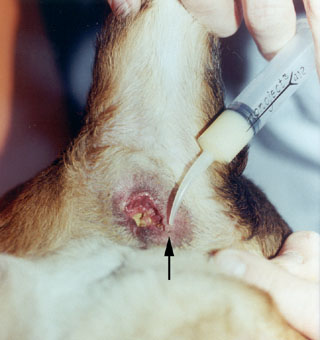F30
Anal Sac Disorders
Introduction:
Dogs have small pouches, located close to the surface of the skin, on either side of the
anus. Comparing the anus to the face of a clock, these pouches or sacs are found
at 4 and 8 o’clock. Each sac connects to the outside by means of a narrow duct
which has an opening that can be seen upon examination. The picture on F30
shows the opening to the anal sac. These anal sacs contain tiny glands that
secrete a foul-smelling fluid which is normally expressed when pressure is
exerted on the area during a bowel movement. This fluid lubricates and marks the
stool with an odor unique to each individual dog, and is thought to serve as a
territorial marker. Most carnivores have anal sacs, but the skunk is the most
infamous for its strong odor; the skunk’s anal "scent" sacs have
actually evolved into a defense mechanism. Many problems can occur with the anal
sacs. Impaction and infection are by far the most common. There are also certain
types of tumors that may arise from the anal sac tissue.
Causative Agents: Anal sac problems usually begin with blockage of the
tiny duct which allows the sac to empty. This causes impaction and
inflammation of the anal sac. The initial impaction is thought to come about as
a result of changes in secretions from the gland, poor
muscle tone, soft feces or diarrhea, and a subsequent retention of gland
material. This often results in bacterial and yeast infections occurring in the
anal sac which can lead to abscesses and rupture of the sac. Some reports
indicate that anal sac problems can be related to allergic reactions to diet and
environment.
Clinical Signs:
At first, the animal acts uncomfortable. This may progress to excessive licking
or chewing at the anal area. These dogs often "scoot" or drag their
hind quarters across the floor. The anal area may be inflamed, red, and painful
to the dog. Other clinical signs may include tail chasing, discomfort in
sitting, rubbing the anus on walls or other objects, straining, and painful
bowel movements. If the problem is severe, the sac can rupture and a foul
smelling, brown discharge may result. If the infection spreads from the anal
sac, the dog may develop a fever. Because the dog may only demonstrate general
discomfort, some cases are difficult to identify.
Diagnosis:
A diagnosis is achieved by observing and feeling the problem anal sac(s). A
normal sac is small and difficult to feel. It can have some discharge but the
discharge is usually clear or pale yellow. An abnormal anal sac is usually
large, inflamed, and is painful to the animal. Some sacs can be impacted with a
very hard material. Once expressed, the discharge may be gritty, brown to green,
foul smelling, and can have blood in it.
Treatment:
The most critical step in
treating these problems involves expressing or draining the diseased anal sac.
This is accomplished by placing a lubricated finger in the rectum, locating the
sac, and then pressing out the contents of the sac. The thumb is placed on the
outside of the sac and skin, and is used to help direct the contents out the
opening at the anus. Some impactions are difficult to remove and require a great
deal of pressure or even insertion of a probe to clear the duct passage for
emptying. Such cases may require sedation or general anesthesia for the pet. Once the sac is
drained, it is standard to infuse an antibiotic-steroid solution into the anal
sac. If necessary, this may need to be performed at home on a daily basis.
If the problem has progressed to an abscess, hot packs are recommended to
help bring the abscess to a head and promote drainage. Once open, an abscess
should be flushed and an antibiotic/steroid solution and ointment should be
placed in the wound. The wound area should be cleaned daily and additional
medications applied. Oral antibiotics are warranted in cases of severe swelling
and fever. In some recurring cases, surgery may be required to remove the sacs.

|
|
|
| The
arrow indicates the opening to the anal sac. This picture shows the
product Panolog being placed into the anal sac using a curved tip
syringe. This is performed after the anal sac is drained or
expressed. The tip on a tube of Panolog can also be used to
administer the ointment. |
|
